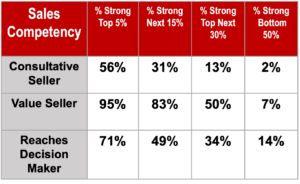- November 2, 2024
- Posted by: Dave Kurlan
- Category: Understanding the Sales Force

In Central Massachusetts, the 2024 Foliage season was dramatically different from a year ago when the leaves turned late in the fall, without much color, and they didn’t drop until the second half of November. Long Foliage Cycle.
This year, much like when I was growing up, the leaves turned in mid-October and had mostly fallen from the trees by the end of October. Short Foliage Cycle.
Which brings me to sales cycles. Do you know what actually determines the length of your sales cycle?
It’s probably not what you think it is.
A lot of sales leaders and their salespeople believe that sales cycles are determined by their industry, or are specific to the industries they sell to. Both scenarios are fake news. In reality, there are only two long sales cycles that seem to be etched in stone:
- You sell to the government and they’re budgeting now for something they’ll buy in the next 2-3 years
- You engineer something where it takes months for your progress to reach the point when your customer agrees to buy it.
Other than those two scenarios, long sales cycles are simply a self-fulfilling prophecy. Believing that “we have a really long sales cycle” pre-determines the sales cycle you experience.
It’s important to understand that your sales cycle length will be significantly shorter when 3 things are in place, but longer when they aren’t:
- You are speaking with the decision maker. Not a buyer or middle manager, but a person or people who has authority to only say NO, but a person or people, with signatory authority.
- You differentiated to the point where you sold your value and the decision maker will spend more to buy from you.
- There is stated urgency.
It’s easier to sell value when there is urgency.
It’s easier to reach the decision maker when there is urgency.
It’s easier to sell value to the decision maker.
It’s easier to create urgency when you are talking with the decision maker.
They are inter-related milestones and they are game changers.
Let’s explore three scenarios:
Scenario 1: You are with the decision maker, you sold value, but you have not uncovered any urgency.
They will either not buy at all (no urgency means it is only nice to have) or it will be a long sales cycle. Add urgency to this scenario and not only will they buy, but the sales cycle will be short. It has nothing to do with what you sell or who you sell to. It has everything to do with urgency.
Scenario 2: You are with someone other than the decision maker, and you sold value and uncovered urgency. Your chance of having a conversation with the decision maker is much greater (because of urgency). Remove urgency from that scenario and your chances of having that decision maker conversation become more unlikely and a longer sales cycle becomes more likely.
Scenario 3: You weren’t able to sell value or reach the decision maker, but there is urgency. However, you are being told ABOUT the urgency from someone who DOESN’T HAVE the urgency, so it is more difficult to leverage. This could result in a shorter sales cycle, but since you didn’t reach the decision maker and sell value, you probably won’t win this business.
As you can see, all three factors are important but your ability to uncover urgency is the single factor that will shorten your sales cycle. If you try to uncover urgency but fail to find it, your sales cycle will not only be longer, there’s a good chance you won’t win the business because companies and people rarely buy when something is not much more than nice to have. You must be able to move your prospects beyond nice to have, and advance them to must have.
Urgency is the outcome of uncovering their compelling reason to buy, monetizing their compelling reason, and learning how quickly they want to solve/take advantage of their problem/opportunity/situation. Urgency occurs through a strong, consultative approach so how can you consistently uncover urgency?
And there’s the problem.
Most salespeople don’t effectively utilize a consultative approach and therefore, lack the ability to uncover urgency. Using statistics from Objective Management Group’s (OMG) assessments of around 2.5 million salespeople, let’s look at the numbers from three of the 21 Sales Core Competencies to better understand how bad this problem is:

As you can see, a little more than half of the top 5% and around a third of the next 15% of salespeople are strong at taking a consultative approach. After that, fuhgeddaboudit (Proper spellingaccording to Google AI)
It’s both a sales training and a sales coaching issue because most salespeople are not exposed this type of sales approach, and of those who are, relatively few sales trainers teach it correctly, it’s rarely demonstrated through role-play, and most salespeople don’t practice. It’s no wonder that most salespeople can’t execute it. For you golfers out there, it’s the difference between 3-putting and 1-putting across an 18-hole round. That gets me down from about a 105 to a 70! For example, a lot of the sales training my firm provides is to companies that weren’t able to execute either SPIN Selling or The Challenger Sale, both being consultative approaches. To use a golf analogy, the consultative approach is the sales equivalent to a chip shot, pitch or lob that puts you within 6 feet of the hole.
If you develop the ability to uncover compelling reasons to buy, create urgency, sell value, and have those conversations with decision makers, you will be amazed at how short your sales cycles will become.
Image copyright 123RF
